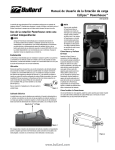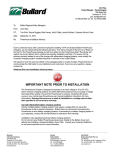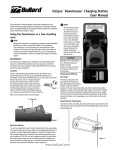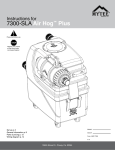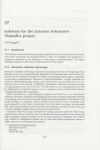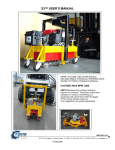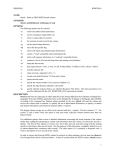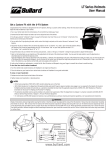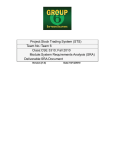Download Eclipse® Powerhouse Charging Station User Manual www.bullard
Transcript
Eclipse® Powerhouse Charging Station User Manual (EU English) The Powerhouse Charging Station is the perfect companion for your Eclipse Thermal Imager. Designed to safely house and charge the Eclipse and an accompanying battery, the Eclipse Powerhouse helps ensure that your Eclipse will always be ready for action. Using the Powerhouse as a freestanding unit: NOTE Although the Powerhouse is designed for permanent vehicle installation, Bullard also provides an optional AC adaptor kit for unattached, free-standing use. As a free-standing unit, the Powerhouse cannot provide secure storage of the thermal imager and its spare battery in a vehicle in accordance with NFPA 1901-14.1.11.2. Free-standing use is not recommended for vehicles. The adaptor kit includes an AC power adaptor. Installation The Powerhouse is designed to be mounted on any convenient flat-panel surface in a vehicle. When installed and used in accordance with these instructions, the unit is designed to comply with NFPA 1901-14.1.11.2 (see caution for proper installation). Location Select a conveniently-located, flat-panel surface of sufficient size to accommodate the unit. The unit can be conveniently mounted in any orientation and will comply with NFPA 1901-14.1.11.2. The unit is secured to the truck by means of two “L”-shaped aluminum brackets. The brackets attach to the truck with four (4) #10 stainless steel countersunk thread-forming Phillips-head screws, which are provided. The Powerhouse attaches to the same brackets with four (4) #10 stainless steel Phillips-head pan screws that are also provided with Figure 1 the unit (Figure 1). Allow 5-inch clearance above to remove Eclipse (Figure 2). 5” clearance Figure 2 www.bullard.com Electrical Wiring Preparing the Powerhouse unit for installation The unit is provided with a pair of wires for attachment to the power supply in the vehicle. The wires are color-coded, with red signifying the positive (+) conductor and black signifying the negative (-) conductor. Provide power to the mounting location from a 5-Ampere fused power source with a voltage of 12-24 VDC. Securely fasten the vehicle’s power supply wire to the matching positive or negative wire from the Powerhouse using twist-on or crimp-style connectors. Consult an electrician if you experience difficulty or require assistance. NOTE For best results, the Powerhouse should be connected to an un-switched circuit that continues to provide power when the vehicle is not in use. Wiring the Powerhouse to a switched circuit may result in discharged imager batteries if the vehicle is left idle for periods of more than a few days at a time. First, make sure that the power is disconnected from the supply wiring. Next, connect the positive power source wire securely to the red conductor located on the back of the Powerhouse. Then connect the negative power source wire securely to the black conductor located on the back of the Powerhouse. The Powerhouse attaches to the same bracket with the four (4) #10 stainless steel Phillips-head pan screws included in your installation kit (Figure 4). You may have to press gently to compress the four rubber anti-vibration pads on the bottom of the Powerhouse in order to properly seat the screws Installation is now complete. Marking and Drilling the Panel Print Figure 3 (located on the next to last page of this manual) and place the template in the desired position in the truck. Mark the locations of the four countersunk holes and electrical wire hole using the template as a guide. Drill four (4) pilot holes using a #25 (0.1495”/3.75mm) drill bit from which the Powerhouse brackets will hang. Also drill a suitably-sized hole in the truck panel through which the Powerhouse wiring will pass, ensuring that there are no sharp edges or burrs that could harm the wiring insulation. Mounting the Powerhouse Once the five holes are drilled, attach the panel-mount brackets with four (4) #10 stainless steel countersunk thread-forming Phillips-head screws that are provided (Figure 4). Operation The Powerhouse charging station is designed to perform the following functions: • Securing the imager in the vehicle in accordance with NFPA 1901-14.1.11.2. • Storing and recharging the battery in the imager and maintaining the battery at full charge. • Securing a spare rechargeable battery in accordance with NFPA 1901-14.1.11.2. • Storing and recharging the spare battery and maintaining it at full charge. Inserting the Eclipse into the Powerhouse NOTE In order to store the Eclipse in the Powerhouse, a battery must be installed in the camera. Without a battery installed, the gripper arms will not automatically secure the camera properly. Therefore, storing a camera without the battery installed can result in non-compliance with NFPA 1901-14.1.11.2, if the arms are not manually closed. Depress the “Bullard” button at the top of the Powerhouse to open the gripper arms. For ease of use, the Eclipse should be oriented so that viewing window is at the top and the lens is at the bottom, with the on/off switch and “Bullard” facing the user (Figure 5). Figure 4 Figure 5 www.bullard.com Set the imager firmly into place in the Powerhouse. The gripper arms will close, and you will hear a “click” as the unit locks into place. If in a noisy environment, gently pull on the camera to ensure that the locking mechanism has engaged; otherwise, the camera will not be properly secured and could pose a hazard in a moving vehicle. As an additional indicator, the Powerhouse “Bullard” button will return to the non-depressed position once the camera has been seated properly (Figure 6). Removing the Eclipse indicates that the battery is fully charged and its charge is being maintained by the Powerhouse unit. NOTE If the charging indicator light flashes between green and red for longer than 15 minutes, your battery is damaged and should be disposed of properly. Removing the Eclipse from the Powerhouse Depress the “Bullard” button at the top of the Powerhouse with your thumb while grasping the imager with your hand. Once the camera has been released by the gripper arms, the imager may be pulled away from the Powerhouse unit. Inserting the spare rechargeable battery into the Powerhouse A spare battery charging port is located at the opposite end of the charging station from the “Bullard” button. Align the battery’s molded grooves with the grooves in the charger. Slide the latch to the open position with one hand and insert the Eclipse battery into the charger with your other hand, releasing both when it locks (Figure 7). Inserting the Eclipse Figure 7 Figure 6 The battery charger is automatically activated when the imager is inserted. Battery charge condition is indicated by the color of the light emitted by the “Bullard” button. A pulsing red light indicates that the battery is being charged; a solid green light If the battery is inserted incorrectly, it will not be possible to fully insert it. In this case, the battery will not snap into place, and the charging circuit will not activate. Battery charge condition is indicated by the color emitted by the sliding latch. A pulsing red light indicates that the battery is being charged; a pulsing green light indicates that the battery is fully charged and its charge is being maintained by the Powerhouse unit. NOTE If the charging indicator light flashes between green and red for longer than 15 minutes, your battery is damaged and should be disposed of properly. www.bullard.com Eclipse™ Powerhouse™ Charging Station User Manual Removing the spare rechargeable battery from the Powerhouse Slide the latch to the open position to release the battery. Lift the battery out of the charger while holding the latch open. � CAUTION The Eclipse Powerhouse is compliant with NFPA 190114.1.11.2 and is able to be mounted in any orientation. Please use caution when choosing a mounting location so that, if the camera is accidentally dropped while being installed in the Powerhouse, it will not injure anyone nearby. For this reason, we do not recommend mounting the Powerhouse on the ceiling of any vehicle. Use only a fused power source of 5 amp capacity and 12-24 VDC voltage. Ensure that the polarity of the power supply wiring is correct. Failure to follow these instructions could result in serious injury or malfunction of the unit. Warranty option, articles that are returned within the warranty period and that, after examination, are shown to Bullard’s satisfaction to be defective, subject to the following limitations: a) Article must be returned to Bullard with shipping charges prepaid. b) Article must not be altered from its original configuration. c) Articles must not have been misused, abused, or damaged in transport. In no event shall Bullard be responsible for damages, loss of use, or other indirect, incidental, consequential or special costs, expenses or damages incurred by the purchaser, notwithstanding that Bullard has been advised of the possibility of such damages. Any implied warranties, including warranties of merchantability and fitness for a particular purpose, are limited in duration to two years from the date of manufacture of this product. Some states do not allow the exclusion or limitation of incidental or consequential damages, or allow limitations on how long an implied warranty lasts, so the above limitations or exclusions may not apply to you. This warranty gives you specific legal rights, and you may have other rights which vary from state to state. Bullard warrants to the original purchaser that the Powerhouse charging station is free of defects in materials and workmanship under intended use and service for a period of two years from date of manufacture. Bullard’s obligation under this warranty is limited to repairing or replacing, at Bullard’s www.bullard.com Eclipse™ Powerhouse™ Charging Station User Manual www.bullard.com E.D. BULLARD COMPANY • PRODUCT EVALUATION REPORT • PRODUCT EVALUATION REPORT NUMBER: PER 5523 DATE: October 3, 2012 TO: Landon Borders CC: Wayne Ruggles, Lincoln Dreher, Adam Halbert, Matt Elmore Product Evaluation Report Files PRODUCT EVALUATED: Eclipse powerhouse with EclipseLD REQUESTED BY: Landon Borders EVALUATED BY: Jeff Himes PURPOSE OF EVALUATION: Testing for Belgium Tender. SPECIMENS: One Truckmount assembly and Eclipse camera was provided by Landon Borders. METHOD: Weight the camera, and then install the camera into the truck mount. Applied 10X the cameras weight (10G’s) to the approximate center of gravity (CG) of the camera in each direction (front, back, left side, right side). A Chatillon Force gauge (ID# 117-017) was used to apply a pull force to the camera sample. The camera was observed to see if it had disengaged/dislodged or maintained in the truck mount. RESULTS: The weight of the Eclipse camera sample was 1.95 lbf. The corresponding force associated with propelling this camera under an acceleration of 10G is 19.5 lbf. Direction of pull Front Back Rightside Leftside Top Force applied (lbf) >20 >20 >20 >20 14 Pass/Fail Pass Pass Pass Pass Fail I certify the above evaluation was conducted in accordance with standard methods. WA Ruggles ------------------------------------Wayne Ruggles Laboratory Manager 1 Americas: Bullard 1898 Safety Way Cynthiana, KY 41031-9303 • USA Toll-free within USA: 877-BULLARD (285-5273) Tel: +1-859-234-6616 Fax: +1-859-234-8987 Europe: Bullard GmbH Lilienthalstrasse 12 53424 Remagen • Germany Tel: +49-2642 999980 Fax: +49-2642 9999829 Asia-Pacific: Bullard Asia Pacific Pte. Ltd. LHK Building 701, Sims Drive, #04-03 Singapore 387383 Tel: +65-6745-0556 Fax: +65-6745-5176 w w w.b ul l a rd. c om ISO 9001 certified ©2015 Bullard. All rights reserved. Eclipse and Powerhouse are trademarks of Bullard. 6050068840D GMBH EN (0815)






